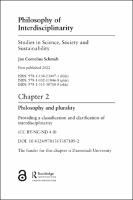Chapter 2 Philosophy and plurality
Proposal review
Providing a classification and clarification of interdisciplinarity
Abstract
What exactly do—and should—the terms “interdisciplinarity” and its cognate “transdisciplinarity” mean? This chapter exposes different understandings of inter- and transdisciplinarity and sets out a foundation for a critique of innumerable usages of these hype terms. It starts by presenting a plurality of motives behind these notions, followed by criteria characterizing the semantic core of the notions, namely (i) the existence of (disciplinary or academic) boundaries and (ii) the transgression or overcoming of those boundaries. Based on the dialectic consideration of boundaries and with reference to well-established distinctions in the philosophy of science, a plurality of four types is shown: interdisciplinarity with regard to (a) objects, (b) knowledge/theories concepts, (c) methods/practices, and further, (d) problems/issues. Different philosophical thought traditions can be related to the four types. All four types can be illustrated by research programs that are labeled “interdisciplinary”: nanoresearch, complex systems theory/chaos theory, biomimicry/bionics, and technology assessment/sustainability research. In this chapter special emphasis is given to the complex relation between interdisciplinarity and transdisciplinarity. Arguments favoring a critical-reflexive concept of problem-oriented interdisciplinarity going beyond what is typically associated with transdisciplinarity are presented. This terminological clarification constitutes the very basis for the Philosophy of Interdisciplinarity set forth in this book.
Keywords
History of Science; History of Technology; Philosophy of Technology; Scientific Ethics; Synthetic BiologyDOI
10.4324/9781315387109-2ISBN
9781138230071, 9781032118468, 9781315387109Publisher
Taylor & FrancisPublisher website
https://taylorandfrancis.com/Publication date and place
2021Imprint
RoutledgeClassification
Impact of science and technology on society


 Download
Download